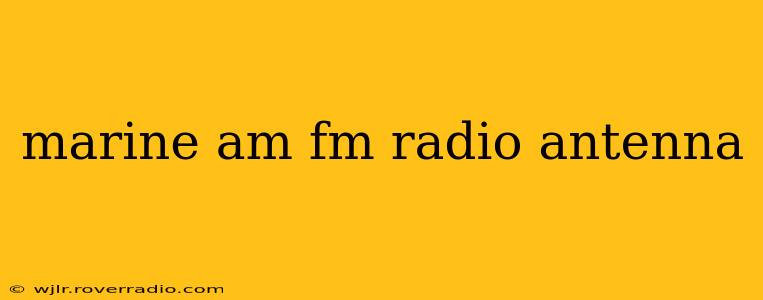Choosing the right marine AM/FM radio antenna is crucial for clear reception on the water. A poorly chosen antenna can lead to frustrating static and missed broadcasts, impacting safety and enjoyment. This guide will help you understand the different types, factors to consider, and how to select the best antenna for your needs.
What are the Different Types of Marine AM/FM Antennas?
Several types of marine AM/FM antennas cater to various boat sizes and mounting preferences. Understanding these differences is key to making an informed decision.
-
Whip Antennas: These are the most common type, featuring a simple, flexible whip mounted vertically. They are relatively inexpensive, easy to install, and offer decent performance, especially for FM reception. However, their AM reception might be less optimal compared to other options.
-
Stainless Steel Antennas: Built for durability and resistance to corrosion, these antennas often boast a longer lifespan than their cheaper counterparts. They frequently incorporate a whip design but with superior materials for longevity in harsh marine environments.
-
Hidden Antennas: For those prioritizing aesthetics, hidden antennas are designed to be less conspicuous. These may be integrated into the boat's structure or cleverly concealed. However, their performance may be slightly compromised compared to exposed antennas.
-
Active Antennas: These antennas include an amplifier to boost the signal, improving reception in areas with weak signals. While beneficial, they require a power source and can be more expensive.
How Do I Choose the Right Marine AM/FM Antenna?
Selecting the ideal antenna involves considering several factors:
-
Boat Size: Larger boats generally benefit from taller antennas for better reception. Smaller boats might be better suited to shorter, more compact options.
-
Mounting Location: The antenna's location impacts reception significantly. A high, unobstructed position is ideal.
-
Frequency Range: Ensure the antenna supports both AM and FM frequencies, as needed.
-
Material and Durability: Opt for corrosion-resistant materials like stainless steel, especially in saltwater environments.
-
Budget: Prices vary considerably; set a budget before starting your search.
What is the Best Marine AM/FM Antenna for My Boat?
There's no single "best" antenna – the optimal choice depends on your specific needs and boat characteristics. Consider the factors discussed above. Reading online reviews and comparing specifications from reputable marine electronics suppliers can aid your decision.
How Do I Install a Marine AM/FM Antenna?
Installation methods depend on the antenna type and boat design. Always consult the manufacturer's instructions for specific guidance. Generally, it involves drilling a hole (for through-hull mounting) or using a strong adhesive (for surface mounting). Proper grounding is crucial for optimal performance.
How Can I Improve My Marine Radio Reception?
Beyond choosing a good antenna, several steps can improve reception:
-
Optimize Antenna Placement: Experiment with different positions to find the one with the clearest signal.
-
Consider Signal Boosters: If reception remains poor, an amplifier or booster might be necessary.
-
Check Cabling: Ensure your coaxial cable is properly connected and free from damage.
Do I Need an AM/FM Antenna for My Boat?
While not strictly essential for all boaters, a marine AM/FM antenna provides access to weather reports, navigational warnings, and entertainment. For safety and convenience, it is highly recommended, particularly for longer voyages or areas with limited cellular service.
This guide provides a comprehensive overview of marine AM/FM antennas. Remember to research and compare options to find the best fit for your boating needs and ensure you have safe and enjoyable time on the water. Remember to always consult a professional marine electrician for complex installations.
